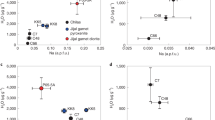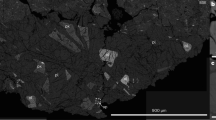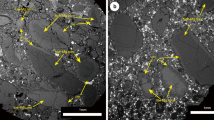Abstract
The Moon is thought to be depleted relative to the Earth in volatile elements such as H, Cl and the alkalis1,2,3. Nevertheless, evidence for lunar explosive volcanism4,5 has been used to infer that some lunar magmas exsolved a CO-rich and CO2-rich vapour phase before or during eruption6,7,8. Although there is also evidence for other volatile species on glass spherules9, until recently10 there had been no unambiguous reports of indigenous H in lunar rocks. Here we report quantitative ion microprobe measurements of late-stage apatite from lunar basalt 14053 that document concentrations of H, Cl and S that are indistinguishable from apatites in common terrestrial igneous rocks. These volatile contents could reflect post-magmatic metamorphic volatile addition or growth from a late-stage, interstitial, sulphide-saturated melt that contained ∼1,600 parts per million H2O and ∼3,500 parts per million Cl. Both metamorphic and igneous models of apatite formation suggest a volatile inventory for at least some lunar materials that is similar to comparable terrestrial materials. One possible implication is that portions of the lunar mantle or crust are more volatile-rich than previously thought.
This is a preview of subscription content, access via your institution
Access options
Subscribe to this journal
Receive 51 print issues and online access
$199.00 per year
only $3.90 per issue
Buy this article
- Purchase on Springer Link
- Instant access to full article PDF
Prices may be subject to local taxes which are calculated during checkout


Similar content being viewed by others
References
Gibson, E. K. & Moore, G. W. Volatile-rich lunar soil: evidence of possible cometary impact. Science 179, 69–71 (1973)
Epstein, S. & Taylor, H. P. The isotopic composition and concentration of water, hydrogen, and carbon in some Apollo 15 and 16 soils and in the Apollo 17 orange soil. 4th Lunar Sci. Conf. 2, 1559–1575 (1973)
Wieczorek, M. A. et al. The constitution and structure of the lunar interior. Rev. Mineral. Geochem. 60, 221–364 (2006)
McGetchin, T. R. & Head, J. W. Lunar cinder cones. Science 180, 68–71 (1973)
Fogel, R. A. & Rutherford, M. J. Magmatic volatiles in primitive lunar glasses. I. FTIR and EPMA analyses of Apollo 15 green and yellow glasses and revision of the volatile-assisted fire-fountain theory. Geochim. Cosmochim. Acta 59, 201–215 (1995)
Wilson, L. & Head, J. W. Deep generation of magmatic gas on the Moon and implications for pyroclastic eruptions. Geophys. Res. Lett. 30, 71–74 (2003)
Sato, M. The driving mechanism of lunar pyroclastic eruptions inferred from the oxygen fugacity behavior of Apollo 17 orange glass. 10th Lunar Planet. Sci. Conf. 311–325 (1979)
Rutherford, M. J. & Papale, P. Origin of basalt fire-fountain eruptions on Earth versus the Moon. Geology 37, 219–222 (2009)
Delano, J. Pristine lunar glasses: criteria, data, and implications. 16th Lunar Planet. Sci. Conf. D201–213 (1986)
Saal, A. E. et al. Volatile content of lunar volcanic glasses and the presence of water in the Moon’s interior. Nature 454, 192–195 (2008)
Sarbas, B. & Nohl, U. in Geoinformatics 2008 — Data to Knowledge (eds Brady, S. R., Sinha, A. K. & Gundersen, L. C.) 42–43 (Report 2008-5172, Proceedings of USGS Scientific Investigations, 2008)
Pan, Y. M. & Fleet, M. E. Compositions of the apatite-group minerals: substitution mechanisms and controlling factors. Rev. Mineral. Geochem. 48, 13–49 (2002)
Brenan, J. Kinetics of fluorine, chlorine, and hydroxyl exchange in fluorapatite. Chem. Geol. 110, 195–210 (1993)
Streck, M. J. & Dilles, J. H. Sulfur evolution of oxidized arc magmas as recorded in apatite from a porphyry copper batholith. Geology 26, 523–526 (1998)
Boyce, J. W. & Hervig, R. L. Magmatic degassing histories from apatite volatile stratigraphy. Geology 36 10.1130/G24184A.1 (2008)
Boyce, J. W. & Hervig, R. L. Apatite as a monitor of late-stage magmatic processes at Volcán Irazú, Costa Rica. Contrib. Mineral. Petrol. 157, 135–145 (2009)
Sclar, C. B. & Bauer, J. F. On the halogen deficiency of lunar apatite. Meteoritics 10, 484–485 (1975)
Liu, Y. et al. Water in lunar mare basalt: confirmation from apatite in lunar basalt 14053. 41st Lunar Planet. Sci. Conf. 2647 (2010)
Greenwood, J. P. et al. Water in Apollo rock samples and the D/H of lunar apatite. 41st Lunar Planet. Sci. Conf. 2439 (2010)
McCubbin, F. M. et al. Detection of structurally bound hydroxyl in apatite from Apollo mare basalt 15058,128 using TOF-SIMS. 41st Lunar Planet. Sci. Conf. 2468 (2010)
Taylor, L. A., Patchen, A., Mayne, R. G. & Taylor, D.-H. The most reduced rock from the moon, Apollo 14 basalt 14053: its unique features and their origin. Am. Mineral. 89, 1617–1624 (2004)
Imai, A. Generation and evolution of ore fluids for porphyry Cu-Au mineralization of the Santo Tomas II (Philex) deposit, Philippines. Resour. Geol. 52, 71–96 (2001)
Imai, A. Metallogenesis of porphyry Cu deposits of the Western Luzon Arc, Philippines: K-Ar ages, SO3 contents of microphenocrystic apatite and significance of intrusive rocks. Resour. Geol. 52, 147–161 (2002)
Imai, A. Variation of Cl and SO3 contents of microphenocrystic apatite in intermediate to silicic igneous rocks of Cenozoic Japanese island arcs: Implications for porphyry Cu metallogenesis in the western Pacific island arcs. Resour. Geol. 54, 357–372 (2004)
Epstein, S. & Taylor, H. P. O18/O16, Si30/Si28, D/H, and C13/C12 ratios in lunar samples. Proc. 2nd Lunar Sci. Conf. 2, 1421–1441 (1971)
Fleck, B. First results from SOHO. Astrophys. Space Sci. 258, 57–75 (1998)
Mathez, E. & Webster, J. Partitioning behavior of chlorine and fluorine in the system apatite-silicate melt-fluid. Geochim. Cosmochim. Acta 69, 1275–1286 (2005)
Henning, P., Adolfsson, E. & Grins, J. The chalcogenide phosphate apatites Ca10(PO4)6S, Sr10(PO4)6S, Ba10(PO4)6S and Ca10(PO4)6Se. Z. Kristallogr. 215, 226–230 (2000)
Saal, A. E., Hauri, E. H., Langmuir, C. H. & Perfit, M. Vapour undersaturation in primitive mid-ocean-ridge basalt and the volatile content of Earth’s upper mantle. Nature 419, 451–455 (2002)
Nadeau, S. L., Epstein, S. & Stolper, E. Hydrogen and carbon abundances and isotopic ratios in apatite from alkaline intrusive complexes, with a focus on carbonatites. Geochim. Cosmochim. Acta 63, 1837–1851 (1999)
Peng, G., Luhr, J. F. & McGee, J. J. Factors controlling sulfur concentrations in volcanic apatite. Am. Mineral. 82, 1210–1224 (1997)
Acknowledgements
This work was funded by grants from NASA Cosmochemistry (NNX08AG54G to L.A.T. and NNX09AG40G to E.M.S.), the NSF (OCE-0840983 to J.W.B.) and the Moore foundation for support of the Caltech Microanalysis Center.
Author information
Authors and Affiliations
Contributions
J.W.B. led the generation and interpretation of the data, and the writing of the Letter. Y.L. prepared the rock section of 14053, collected BSE and EMP data, and contributed to the data interpretation and paper writing. G.R.R. conducted the infrared analyses of the apatites used for SIMS standards, performed the necessary calibrations of the infrared data and contributed to the data interpretation and paper writing. Y.G. set up the SIMS instrument, assisted in the formulation of the analytical protocol, carried out the SIMS measurements, and assisted in data processing and discussion. J.M.E. is the director of the Caltech Center for Microanalysis, and contributed to the data analysis and paper writing. E.M.S. contributed to the data interpretation and the paper writing. L.A.T initiated the collaboration, was allocated the 14053 sample by NASA, and contributed to the data interpretation and paper writing.
Corresponding author
Ethics declarations
Competing interests
The authors declare no competing financial interests.
Supplementary information
Supplementary Information
This file contains Supplementary Information comprising Sample Description, Analytical Notes, Partition Coefficients, Supplementary Figures 1-5 with legends, References and Supplementary Tables 1-2. (PDF 424 kb)
Rights and permissions
About this article
Cite this article
Boyce, J., Liu, Y., Rossman, G. et al. Lunar apatite with terrestrial volatile abundances. Nature 466, 466–469 (2010). https://doi.org/10.1038/nature09274
Received:
Accepted:
Issue Date:
DOI: https://doi.org/10.1038/nature09274
This article is cited by
-
The Exosphere as a Boundary: Origin and Evolution of Airless Bodies in the Inner Solar System and Beyond Including Planets with Silicate Atmospheres
Space Science Reviews (2022)
-
A dry lunar mantle reservoir for young mare basalts of Chang’e-5
Nature (2021)
-
Measuring in situ CO2 and H2O in apatite via ATR-FTIR
Contributions to Mineralogy and Petrology (2021)
Comments
By submitting a comment you agree to abide by our Terms and Community Guidelines. If you find something abusive or that does not comply with our terms or guidelines please flag it as inappropriate.




